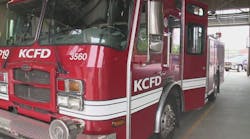Over the past five years, I have been fortunate having had the opportunity to observe and comment on the applications of marketing management to the fire and emergency services. When I was given the green light to begin this column in 2000, I was excited, but privately worried about running out of material after a year or so.
Little did I know that soon after I began my column I would ever be able to become a part of a great international organization – Walt Disney Co. – with one of the finest fire departments in the world. Many people in the fire service do not know the indisputable standards of Reedy Creek Fire and Rescue or that the National Fire Protection Association (NFPA) adopted the “Epcot Code†as a model for fire and life safety. Nor did I ever imagine that Disney, in partnership with Liberty Mutual Insurance Co., would let me be a part of a public fire education experience – “Where’s the Fire?†– attracting millions of people.
This June, the NFPA will have its national meeting in Orlando. I hope those of you who attend will come over to see “Where’s the Fire?†at Epcot. Being at Disney and engaged with the fire service and the protection industry has given me a tremendous vantage point to see emerging trends. The fact is that I have so much material and interest now from so many parts of our profession – including the international arena – that I could keep writing about marketing applications to fire and rescue for the next 10 years. I would like to offer some observations on the present state of marketing for the fire and emergency services as well as some emerging trends.
Whose “Voice†Gets Heard?
When I first began writing for Firehouse, I observed that public service marketing was the sleeping giant of marketing, and that fire service marketing management would become the sleeping giant of public service marketing. The truth of this observation is evolving in front of our eyes. The American Advertising Association reports that in 2004 the average U.S. consumer received over 4,000 commercial messages in some form daily!
I do not know how many of these were public service messages, but can bet that they are increasing in number, if not sophistication and projection. We are not there yet – locally nor nationally – but we are moving slowly in the right direction. The problem is that we do not live in a slow-moving society. The question is: Will we create our own future with our own voice, and by doing so ensure the safety of our citizens, or will we continue to be on the sideline and let someone else do it?
Our approaches are inconsistent at best with many national organizations contending to become “our voice.†The command, “Lead, follow or get out of the way†comes to mind. The glaring example of this is the way we have allowed ourselves to be handled in relation to homeland security where the “police tail is wagging the fire dog.†The local example is the decision to allow the New York Police Department to run the emergency command of a possible terrorist attack in New York. How would you like to have a police officer running your fire? Another example is that we have no control or input into the valuable equity of the Maltese cross and use of the image of firefighters in the media.
There are more fire service organizations in this country than one can comprehend considering the size of the entire fire protection community: suppression (volunteer, paid and combination departments), prevention and the significant number of industries with direct applications such as insurance, building, manufacturing companies and their distributors.
Building Awareness
Thanks to some present and past leaders with a vision, we have made our presence known politically. But as Firehouse political columnist Hal Bruno has intimated so many times, there is a constant need of a strategic focus with specific tactics to achieve our vision: fire and life safety for all citizens day and night everywhere in our country.
This means that every citizen within the jurisdiction of all 30,000-plus fire departments are aware of what we do, why we do it and why it’s important – and that they support us in the community, both politically and financially. This kind of awareness gives us the opportunity to educate our citizens about how to take care of themselves in the first 72 hours of any catastrophe. It is like a circular, reinforcing mechanism that creates new opportunities to market ourselves even better as we become even more attentive to our citizens’ present and emerging safety needs. Here are a few observations and trends with the attendant opportunities to consider for your review. I am presenting these trends in order of the strength of their apparent marketing opportunities. The question is which organizations – or coalitions of organizations – can achieve the goals inherent in the opportunities.
Trend 1: The National Agenda
The national political agenda of the fire protection community will continue to press for funding (the FIRE Act) and support to place the fire and emergency services in the center of all potential and probable hazards. The key, huge implication here is our place in homeland security as well as our own political and financial future locally.
Trend 2: Emerging and Changing Demographics
The changing demographics of the United States provide emerging opportunities for the fire protection community to market itself to minorities for political support as well as entrance into the profession. This does not just mean firefighters. It means fire protection engineers and public safety prevention and education professionals. These minorities are not just Hispanic, African Americans and women. It means Asians, Russians and Eastern Europeans.
Trend 3: Comprehensive Fire and Life Safety Prevention and Education Rules
The emergence of comprehensive fire and public safety prevention and education continues apace. The coalescence of multiple organizations and private-sector alliances can grow this trend. This is one of the most prominent and quickly moving trends I see. It is one that can only strengthen a multiple-disciplinary approach to the majority of our safety problems.
Look for the rise of the fire marshal, fire inspector, public fire safety educator and fire protection engineer as heroes, with firefighters, of the municipal and national fire service.
Trend 4: The Emergence of Disaster Preparedness and Emergency Management
The emergence of disaster preparedness and emergency management as a key area of influence for the fire and life safety agencies is growing. Observing the emerging climate and local meteorological trends, we will be able to blend our two disciplines to use marketing management to further protect our communities. Remember, there is a complete professional discipline dedicated to fire weather.
Trend 5: Public Understanding of What Elements and Measurements Constitute the Quality Standards of a Fire and Life Safety Department
The growth and reinforcement of quality standards – the Commission on Fire Accreditation International Inc. (CFAI) – as the bellwether of public and private industry’s acknowledgment of what makes a great and responsive fire and rescue department.
Trend 6: International Cooperation and Education
The emergence of international cooperation in fire and life safety in the public and private sectors will provide lessons we can apply to our own jurisdictions. This is an area set to explore and only a few visionary fire officers see it. Here is an astounding statistic: according to the CTIF, an international association of fire and rescue services, Russia lost 24,000 of its citizens to fire in 2004!
These trends are nothing new. They have been growing and evolving over the last five years. The question is how the fire and emergency services will create specific action plans organizationally and individually to strengthen itself to contribute more effectively to our local communities and our society. The ball, as always, is in our court, but it is strength of our leadership that will point the way.
Ben May, a Firehouse® contributing editor, has been developing the discipline of fire and emergency services marketing management for more than 15 years. He has been a firefighter for Montgomery County, MD, Fire and Rescue and fire commissioner for the Woodinville, WA, Fire and Life Safety District. May holds a bachelor’s degree in public affairs from the University of Oklahoma and a master’s degree in international communication from the American University in Washington, D.C. He has been a vice president of two international marketing firms over the last 25 years, and now is responsible for business development for Epcot at Walt Disney World Resort.





